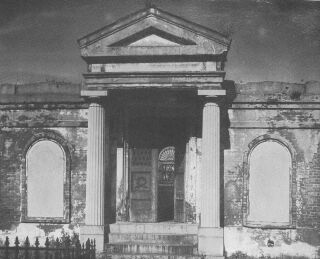

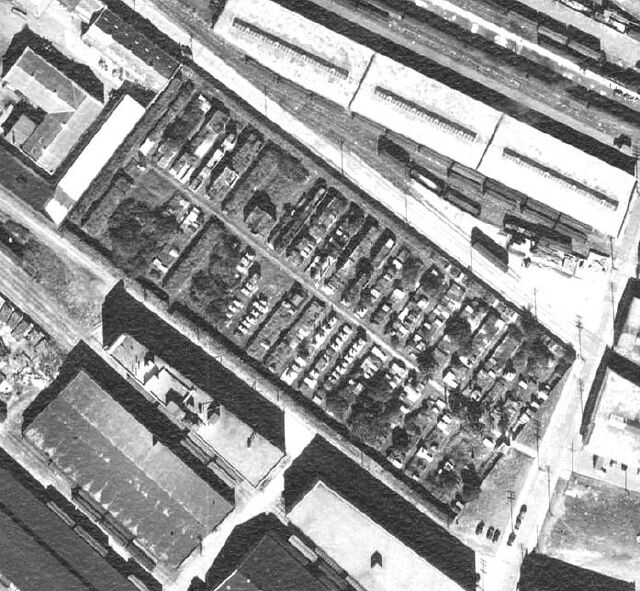
| Old Girod Street Cemetery |
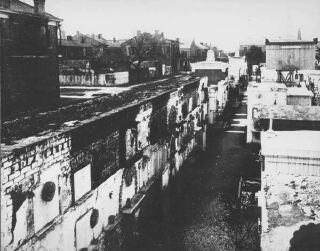
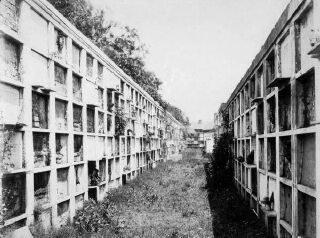
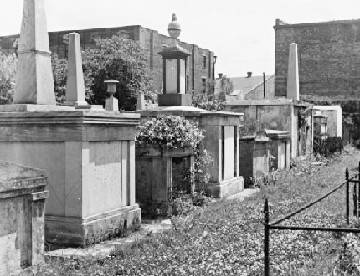
| Above, an aerial view of the Girod Street Cemetery not long before it was destroyed. |
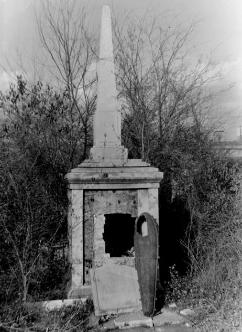
| Girod Street Cemetery, 1864 |
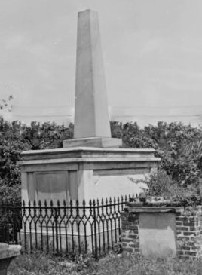
| Tomb of John David Fink, 1940's |
| Tomb of the Lusitanos Benevolent Association, 1940's |
| Vaults, 1894 |
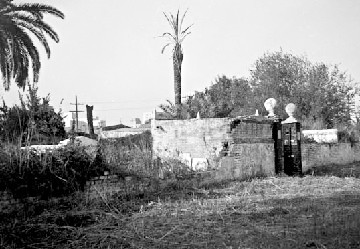
| Entrance, 1953 |
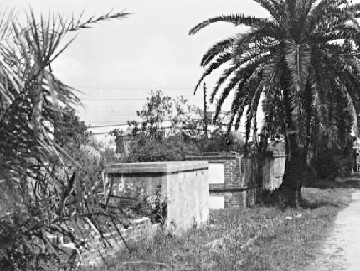
| Two views of the cemetery, 1942 |
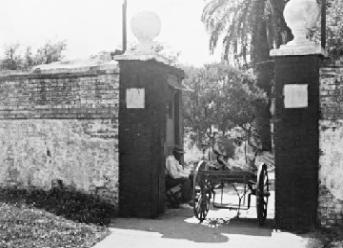
| Entrance, 1942 |
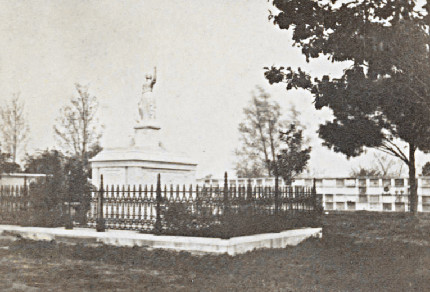
| Girod Street Cemetery, 1930's |
The Girod Street Cemetery came into being in 1822. It was initially established for Protestant
residents of the Faubourg St. Mary community and beyond. Until that time, Protestants had
been buried in a special section of Catholic St. Louis Cemetery Number 1. Christ Church (now
Christ Church Cathedral) purchased the land at a cost of a little over $3,000. The cemetery
was named for one of the streets which formed its boundary - the street, at the time of its
creation, having been named for a distinguished citizen of the community.
And, speaking of distinguished, the old Girod Street Cemetery held the mortal remains of
some of the most distinguished citizens of the time. In fact, some of the tombs were
comparable in extravagance to the tombs on "Millionaires' Row" in Metairie Cemetery. But,
sadly, by the time the old cemetery was de-consecrated in 1957, it had fallen into serious
disrepair from the twin ravages of time and neglect. Girod Street Cemetery had been used for
134 years. Since it was not a publicly owned cemetery and since many of those who were
buried there no longer had family members in the city to take care of the tombs and crypts, it
had gradually been reduced considerably from its former state.
In 1957, the city was planning a new civic center - a complex of city, state and federal facilities
- on a piece of land that included a portion of the old Girod Street Cemetery. It was decided
that the cemetery would be de-consecrated and the remains of those who hadn't been
removed by their families would be moved to Hope Mausoleum, to a common crypt that Christ
Church Cathedral provided without charge. After the removal of remains took place, the
tombs and vaults in the cemetery were destroyed to make way for the new civic buildings.
Thirteen of the most outstanding vault slabs were preserved and attached to the back wall of
the Canal Street wing of Hope Mausoleum, in adjacent St. John Cemetery.
The civic complex, however, didn't cover the entire site of the former burying ground. In
1970, the Louisiana Superdome was constructed on top of the remaining portion of what had
been the Girod Street Cemetery. Over the not-so-good football years, those of us who were
loyal (though impatient and not very happy) Saints' fans searched for a reason for the team's
continuing bad luck. Of the many who were blamed - owners, managers, coaches, players -
eventually, it was suggested that the restless spirits of the old Gird Cemetery, angry that their
final resting places had not been final, were haunting both the Dome and the team.
You're smiling...but I can tell you that, after enough years of football heartbreak, anything, no
matter how far-fetched, can sound vaguely plausible...or else, why would so many of us, who
were otherwise rational human beings, have carried our fake gris-gris with us the Dome or
worn the same outfit every game day or dutifully closed our eyes when a field goal was
kicked...all in hopes of influencing the outcome!?
In any case, if the ghosts of the good citizens of a cemetery long past were ever, indeed,
irritated by a team irreverently called the Saints - or by the irreverent crowds who cheered
them on - trespassing on their former resting places, we can only hope that they have, at last,
been calmed. And that, perhaps, they are enjoying the team's happy times as much as the rest
of us are.
residents of the Faubourg St. Mary community and beyond. Until that time, Protestants had
been buried in a special section of Catholic St. Louis Cemetery Number 1. Christ Church (now
Christ Church Cathedral) purchased the land at a cost of a little over $3,000. The cemetery
was named for one of the streets which formed its boundary - the street, at the time of its
creation, having been named for a distinguished citizen of the community.
And, speaking of distinguished, the old Girod Street Cemetery held the mortal remains of
some of the most distinguished citizens of the time. In fact, some of the tombs were
comparable in extravagance to the tombs on "Millionaires' Row" in Metairie Cemetery. But,
sadly, by the time the old cemetery was de-consecrated in 1957, it had fallen into serious
disrepair from the twin ravages of time and neglect. Girod Street Cemetery had been used for
134 years. Since it was not a publicly owned cemetery and since many of those who were
buried there no longer had family members in the city to take care of the tombs and crypts, it
had gradually been reduced considerably from its former state.
In 1957, the city was planning a new civic center - a complex of city, state and federal facilities
- on a piece of land that included a portion of the old Girod Street Cemetery. It was decided
that the cemetery would be de-consecrated and the remains of those who hadn't been
removed by their families would be moved to Hope Mausoleum, to a common crypt that Christ
Church Cathedral provided without charge. After the removal of remains took place, the
tombs and vaults in the cemetery were destroyed to make way for the new civic buildings.
Thirteen of the most outstanding vault slabs were preserved and attached to the back wall of
the Canal Street wing of Hope Mausoleum, in adjacent St. John Cemetery.
The civic complex, however, didn't cover the entire site of the former burying ground. In
1970, the Louisiana Superdome was constructed on top of the remaining portion of what had
been the Girod Street Cemetery. Over the not-so-good football years, those of us who were
loyal (though impatient and not very happy) Saints' fans searched for a reason for the team's
continuing bad luck. Of the many who were blamed - owners, managers, coaches, players -
eventually, it was suggested that the restless spirits of the old Gird Cemetery, angry that their
final resting places had not been final, were haunting both the Dome and the team.
You're smiling...but I can tell you that, after enough years of football heartbreak, anything, no
matter how far-fetched, can sound vaguely plausible...or else, why would so many of us, who
were otherwise rational human beings, have carried our fake gris-gris with us the Dome or
worn the same outfit every game day or dutifully closed our eyes when a field goal was
kicked...all in hopes of influencing the outcome!?
In any case, if the ghosts of the good citizens of a cemetery long past were ever, indeed,
irritated by a team irreverently called the Saints - or by the irreverent crowds who cheered
them on - trespassing on their former resting places, we can only hope that they have, at last,
been calmed. And that, perhaps, they are enjoying the team's happy times as much as the rest
of us are.
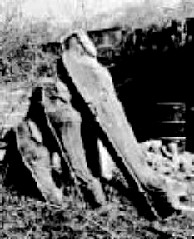
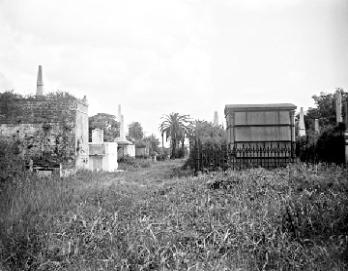
| To the left, 1950; above, date unknown |
| The link to this page is: http://old-new-orleans.com/NO_Girod_Cemetery.html Back to Old New Orleans Whispsers - Home |